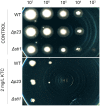The Hsp90 Co-chaperones Sti1, Aha1, and P23 Regulate Adaptive Responses to Antifungal Azoles
- PMID: 27761133
- PMCID: PMC5050212
- DOI: 10.3389/fmicb.2016.01571
The Hsp90 Co-chaperones Sti1, Aha1, and P23 Regulate Adaptive Responses to Antifungal Azoles
Abstract
Heat Shock Protein 90 (Hsp90) is essential for tumor progression in humans and drug resistance in fungi. However, the roles of its many co-chaperones in antifungal resistance are unknown. In this study, by susceptibility test of Neurospora crassa mutants lacking each of 18 Hsp90/Calcineurin system member genes (including 8 Hsp90 co-chaperone genes) to antifungal drugs and other stresses, we demonstrate that the Hsp90 co-chaperones Sti1 (Hop1 in yeast), Aha1, and P23 (Sba1 in yeast) were required for the basal resistance to antifungal azoles and heat stress. Deletion of any of them resulted in hypersensitivity to azoles and heat. Liquid chromatography-mass spectrometry (LC-MS) analysis showed that the toxic sterols eburicol and 14α-methyl-3,6-diol were significantly accumulated in the sti1 and p23 deletion mutants after ketoconazole treatment, which has been shown before to led to cell membrane stress. At the transcriptional level, Aha1, Sti1, and P23 positively regulate responses to ketoconazole stress by erg11 and erg6, key genes in the ergosterol biosynthetic pathway. Aha1, Sti1, and P23 are highly conserved in fungi, and sti1 and p23 deletion also increased the susceptibility to azoles in Fusarium verticillioides. These results indicate that Hsp90-cochaperones Aha1, Sti1, and P23 are critical for the basal azole resistance and could be potential targets for developing new antifungal agents.
Keywords: Hsp90; aha1; azole; co-chaperone; drug resistance; p23; sti1.
Figures






Similar articles
-
Coordinated Regulation of Membrane Homeostasis and Drug Accumulation by Novel Kinase STK-17 in Response to Antifungal Azole Treatment.Microbiol Spectr. 2022 Feb 23;10(1):e0012722. doi: 10.1128/spectrum.00127-22. Epub 2022 Feb 23. Microbiol Spectr. 2022. PMID: 35196787 Free PMC article.
-
Characterization of the interaction of Aha1 with components of the Hsp90 chaperone machine and client proteins.Biochim Biophys Acta. 2012 Jun;1823(6):1092-101. doi: 10.1016/j.bbamcr.2012.03.014. Epub 2012 Apr 5. Biochim Biophys Acta. 2012. PMID: 22504172
-
Integration of the accelerator Aha1 in the Hsp90 co-chaperone cycle.Nat Struct Mol Biol. 2013 Mar;20(3):326-31. doi: 10.1038/nsmb.2502. Epub 2013 Feb 10. Nat Struct Mol Biol. 2013. PMID: 23396352
-
p23 and Aha1: Distinct Functions Promote Client Maturation.Subcell Biochem. 2023;101:159-187. doi: 10.1007/978-3-031-14740-1_6. Subcell Biochem. 2023. PMID: 36520307 Review.
-
p23 and Aha1.Subcell Biochem. 2015;78:113-31. doi: 10.1007/978-3-319-11731-7_6. Subcell Biochem. 2015. PMID: 25487019 Review.
Cited by
-
FRET Assays for the Identification of C. albicans HSP90-Sba1 and Human HSP90α-p23 Binding Inhibitors.Pharmaceuticals (Basel). 2024 Apr 17;17(4):516. doi: 10.3390/ph17040516. Pharmaceuticals (Basel). 2024. PMID: 38675476 Free PMC article.
-
Effect of Nitrosative Stress on the S-Nitroso-Proteome of Paracoccidioides brasiliensis.Front Microbiol. 2020 Jun 4;11:1184. doi: 10.3389/fmicb.2020.01184. eCollection 2020. Front Microbiol. 2020. PMID: 32582109 Free PMC article.
-
Hsp90 inhibitors radicicol and geldanamycin have opposing effects on Leishmania Aha1-dependent proliferation.Cell Stress Chaperones. 2017 Sep;22(5):729-742. doi: 10.1007/s12192-017-0800-2. Epub 2017 Apr 28. Cell Stress Chaperones. 2017. PMID: 28455612 Free PMC article.
-
Discovery of New Broad-Spectrum Anti-Infectives for Eukaryotic Pathogens Using Bioorganometallic Chemistry.J Med Chem. 2023 Dec 14;66(23):15867-15882. doi: 10.1021/acs.jmedchem.3c01333. Epub 2023 Nov 27. J Med Chem. 2023. PMID: 38009931 Free PMC article.
-
Retinoids as Alternative Antifungal Agents Against Candida albicans: In Vitro and In Silico Evidence.Microorganisms. 2025 Jan 22;13(2):237. doi: 10.3390/microorganisms13020237. Microorganisms. 2025. PMID: 40005604 Free PMC article.
References
-
- Agarwal A. K., Rogers P. D., Baerson S. R., Jacob M. R., Barker K. S., Cleary J. D., et al. . (2003). Genome-wide expression profiling of the response to polyene, pyrimidine, azole, and echinocandin antifungal agents in Saccharomyces cerevisiae. J. Biol. Chem. 278, 34998–35015. 10.1074/jbc.M306291200 - DOI - PubMed
LinkOut - more resources
Full Text Sources
Other Literature Sources
Molecular Biology Databases

